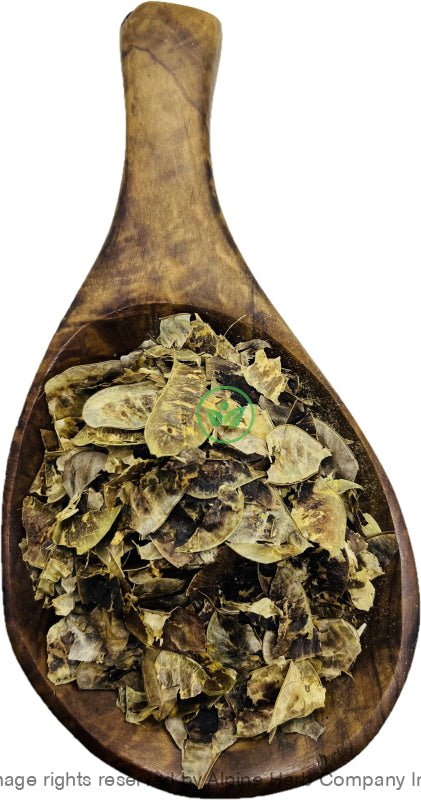Senna Pods Cut Alpine Herb Company Inc.
$ 6,99 $ 4,19
Botanical Name: Senna species
Common Name:
- English: Senna, Sonamukhi
- Ayurvedic: Svarna-pattri, Maarkandikaa, Maarkandi.
- Unani: Sannaa, Sanaa-makki, Senaai, Sonaamukhi, Sanaa-Hindi.
- Siddha: Nilaavaarai
- Also, known as: Alexandrian Senna, Nubian Senna, Cassia Senna, Cassia Lenitive, Cassia Lanceolate, Cassia Officinalis, Cassia Aethiopica, Senna Acutifolia, Egyptian Senna, Sene De La Palthe, Tinnevelly Senna, Cassia Angustifolia, Eást Indian Senna, Wild Senna, Locust Plant, M¡Danc, Sonamukhi, Svamamukhi, Sonapata, Indian Senna. Tinnevelly Senna, Mindhiaval, Sonamukhi, Sanaya, Hindisana, Nelavarika, Sonamukhi, Nelaavare, Nelavarike, Nel Aanriake Sna, Sunnamukhi, Nilavaka, Chinnukki, Adapatiyan, Sonamukhi, Sunamukhi, Sannamakhi, Sanapati, Sarnapatta, Nilapponnai, Avarai, Sunamukhi, Sena, Barg-E-Sana, Falajin, Fan Xie Ye, Fi Laskon Maka, Hindisana, Illesko, Indian Senna, Ma Khaam Khaek, Makhaam Khaek, Mecca Senna, Msahala, Nelaponna, Nelatangedu, Nilavaka, Nilavirai, Nubia Senna, Rinji, Sanai, Sand Hijazi, Sanjerehi, Sen De Alejandria, Sen De La India, Senna Makki, Senna, Snamikki, Sennae Folium, Sonamukhi, Tinnevelly Senna, True Senna
Habitat: Southern India
Origin: India
Harvested: Wild
Parts Used: Leaves
General Information:
Senna consists of dried leaves of Cassia angustifolia, a small shrub, 60-75 cm high, found throughout the year, cultivated largely in Southern India, especially in districts of Tinnevelly, Madurai and Tiruchirappalli and has also, been introduced in Mysore, fully grown, thick bluish color leaves stripped off by hand, collected and dried in shade for 7-10 days, till assume a yellowish-green color, graded and then packed into large bales.
The leaves have long petioles, ovate at base; each petiole has eight or ten leaflets, which are oblong, smooth, 1–2 in. long and quite narrow. The flowers are a bright yellow and the leaves are gathered while in bloom from June to September. The fruit is a legume, 2–4 in. long, and contains a quantity of thick pulp which is mildly laxative and cathartic and is used in the composition of the confection of Cassia and of Senna. It belongs to the sugar class of laxatives, its properties being due, for the most part, to the water-attracting properties of the sugar while in the intestinal canal.
How to use:
Hot Infusion:
The basic method for dried herbs and flower is, take 2-3 tablespoons of dried herb in a cup or teapot. Pour hot water over it and cover it with lid for 10-30 minutes. Hot water is needed to draw out the antioxidants, enzymes, vitamins, flavonoids, and volatile oils from the botanicals. Strain and squeeze out as much as liquid as possible and enjoy!
Tips:
- You can sweeten your herbal tea with a bit of honey, natural fruit juice, stevia leaves powder and or licorice root powder.
- You can make ice cubes or pops by freezing tea in ice trays or pop molds.
Precautions:
You should consult with a qualified healthcare practitioner before using any herbal products, particularly if you are pregnant, nursing, or on any medications.
All information on this website is for educational purposes ONLY.
This information has not been evaluated by Health Canada.
This information is not intended to diagnose, treat, cure, or prevent any disease.
| Unit Size | 100g, 200g, 400g, 1kg |
|---|
Prompt shipping and expert packing
Thanks to our longstanding association with UPS FedEx DHL as well as other leading global carriers, we can offer a variety shipping options. Our warehouse staff is highly trained and will be able to pack your goods in accordance with our precise and exact specifications. Your items will go through an exhaustive examination before they will be securely packaged before being delivered. We ship to hundreds of thousands of customers daily in different countries. This is a sign of our determination to become the largest online retailer worldwide. Warehouses and distribution centers are located throughout Europe as well as in the USA.
Note that orders containing multiple items are processed according to the particular item.
We will thoroughly inspect all items ordered before shipping. Most orders are shipped within 48 hours. The delivery time will be between 3 and 7 working days.
Returns
The stock market is always changing. It's not entirely managed by us since we're involved with several entities, including the factory and the storage. Therefore, the actual inventory could fluctuate at any moment. Please be aware that it is possible that your order could be out of stock after you've placed your order.
Our policy lasts for 30 days. If it's been more than 30 days since the date you purchased your item We're sorry to say that we can't offer you a full exchange or refund.
You can only return a product if it is unused and still in the same state as when you received it. The item should be in the original packaging.


































